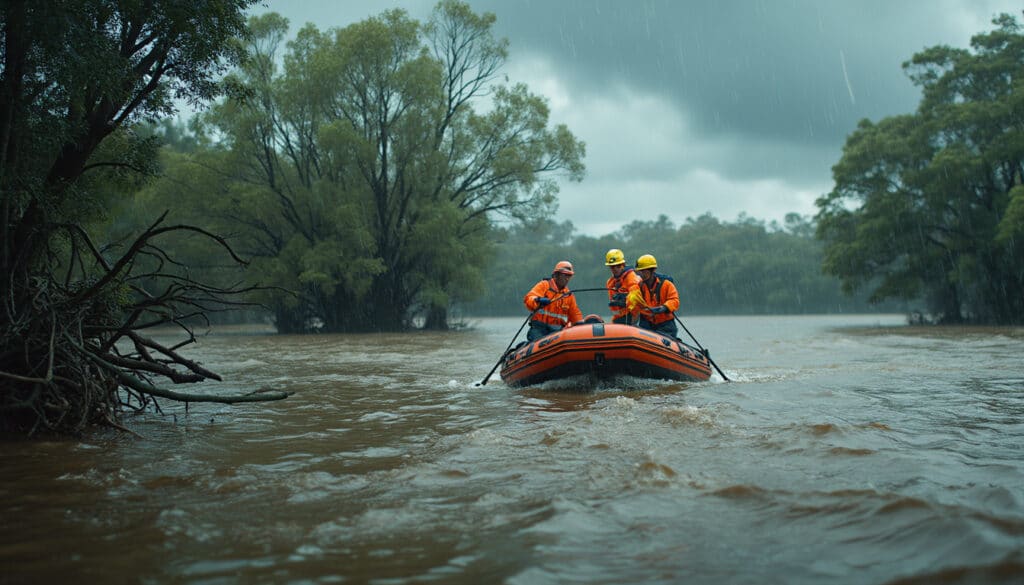Heavy rains have struck eastern Australia, plunging many areas into water. Authorities warn of a possible prolonged isolation of inland communities. Waves are crashing, making daily life extremely difficult.
Weather forecasts predict even more intense rains, threatening infrastructure and homes. Search efforts are underway to find a man missing in the Barnard River. Rescue teams continue to respond to flash flooding situations. Residents in affected areas are urged to prepare for a potential isolation that could last up to six weeks.
Intensive search for a man missing in the flooded waters of NSW
Authorities continue to conduct a relentless search for an elderly man who was swept away by the turbulent waters of the Barnard River in Bretti, north of Gloucester, in the inland region of NSW. Saturday night was marked by exceptional rains that caused record flooding along the east coast of Australia, isolating some rural areas for several weeks. The extreme weather conditions make rescue operations particularly arduous, highlighting the severity of the situation.
The missing person’s vehicle, towing a caravan, was attempting to cross a submerged crossing when it was swept away by the powerful currents. This tragedy occurs as rescue services report an increase in flash floods across vast areas of eastern Australia. Debbie Platz, Deputy Commissioner of the NSW State Emergency Services, emphasized the need for communities near the NSW-Queensland border to prepare for a prolonged isolation. “Some regions may be cut off from the rest of the country for up to six weeks,” she stated.
What are the causes of record floods in eastern Australia?
The devastating floods affecting eastern Australia are primarily due to an extremely dynamic and unpredictable weather system. This situation has resulted in intense rainfall over a very short period, saturating already wet soils and causing flash floods. In March, some parts of inland Queensland experienced their rainiest day in 15 years, exacerbating the risks of rapid inundation.
The violent winds associated with this system have worsened the situation by transporting water from Queensland rivers to NSW, where the Paroo and Warrego rivers have overflowed, submerging surrounding communities. This accumulation of water in river systems has created conditions conducive to sudden flooding, further complicating rescue operations. The weather forecast indicates the imminent arrival of another rain system, further intensifying risks for already affected regions.
What is the impact of flooding on local communities?
The consequences of the flooding are devastating for local communities, both humanely and economically. Over 20 people have found themselves trapped in an isolated campground after rising waters cut access via a causeway bridge. Despite the arrival of a rescue helicopter at 3 a.m., residents chose not to evacuate, increasing difficulties for search teams.
Livestock losses are also significant in areas where flooding has been most severe, jeopardizing food security and the livelihoods of local farmers. Moreover, road infrastructure is suffering substantial damage. Several major roads in NSW, including part of the Silver City Highway linking Broken Hill to the Queensland border, remain closed, limiting access to isolated areas and complicating rescue efforts.
How are authorities responding to the crisis?
In the face of the magnitude of the disaster, local and national authorities have mobilized considerable resources to manage the situation. Debbie Platz, Deputy Commissioner of NSW Emergency Services, has overseen rescue operations, which have already led to 19 rescues in 24 hours. Rescue teams are using helicopters and ground units to locate people in distress in flooded areas.
Queensland Premier, David Crisafulli, warned that the worst of the flooding has not yet occurred, highlighting the risk of flooding homes and urging residents to remain vigilant. Mass evacuations have already taken place in remote towns like Jundah, where about 20 residents have been relocated to Longreach for safety reasons. Meanwhile, financial aid and grants are being implemented to support farmers and affected communities.
What are the weather forecasts for the upcoming days?
Weather forecasts indicate that the climate in eastern Australia will remain unstable in the coming days, with the arrival of a new rain system expected this week. This system is anticipated to bring additional precipitation, further accumulating water in already saturated catchment areas. Senior meteorologist Jonathan How from the Bureau of Meteorology explains that “the water will take time to recede, meaning flood warnings will persist.”
The most affected regions, such as the Gold Coast, hinterland, Brisbane, Capricornia, and the northern tropical coast, have already recorded massive rainfall, often exceeding 50 mm in 24 hours. The Sunshine Coast has even experienced doubled rainfall in some areas. In contrast, Sydney has been relatively spared, with totals of 5 mm to 15 mm in 24 hours, limiting damage but still requiring ongoing vigilance.
What practical measures can residents take in the face of flooding?
In light of the persistent flooding and the risks of new precipitation, it is essential that residents in affected areas take precautionary measures to ensure their safety. Debbie Platz and emergency services recommend staying informed of weather updates and following the instructions of local authorities. Preparedness is crucial, particularly by reinforcing temporary barricades and evacuating the most vulnerable areas if necessary.
It is also recommended to stockpile potable water, non-perishable food, and essential medications to cope with a potential prolonged isolation. Communities should establish evacuation plans in case of emergency and ensure that all members, including children and the elderly, are informed of the procedures to follow. Additionally, communication with neighbors and family members can strengthen collective resilience in the face of the challenges posed by flooding.
What are the challenges of rescue operations in flooded environments?
Rescue operations in flooding conditions present numerous logistical and safety challenges. Rescue teams must navigate through shifting terrain and fast currents, often under conditions of limited visibility and heavy rain. Limited access to isolated areas further complicates efforts, requiring the use of helicopters and specialized equipment to reach people in distress.
Furthermore, the saturation of road infrastructure hampers mobility for rescue teams, making it difficult to rapidly deploy necessary resources. The fatigue and stress of rescuers working in extreme environments can also affect the effectiveness of operations. Despite these obstacles, authorities and rescue teams continue to deploy all possible means to locate and save endangered individuals, as evidenced by the ongoing search for Marc in the flooded waters of the Barnard River.
For more information on rewilding initiatives and sustainability efforts, you can read this article about a mysterious donor offering £175 million to transform a Scottish estate into a showcase for rewilding.
What are the economic impacts of flooding on the agricultural sector?
Flooding has a devastating impact on the agricultural sector, primarily due to massive losses of livestock and crops. Farmers in affected regions find their livelihoods threatened, with livestock losses compromising not only their immediate income but also their ability to produce in the long term. Saturated soils delay crop cycles, leading to crop losses and reduced productivity.
Financial aids, such as low-interest loans and freight subsidies, are critical in helping producers recover from the damage. However, recovery can be slow, especially if flooding persists or new rain systems develop. Economic losses also extend to local industries, with businesses shut down and infrastructure damaged, creating a domino effect on the regional economy.
How are road infrastructures affected by flooding?
Flooding has a devastating effect on road infrastructure, making travel dangerous and limiting access to affected areas. The Silver City Highway, for instance, is partially closed from Broken Hill to the Queensland border, further isolating rural communities. Submerged and damaged roads require costly and time-consuming repairs, delaying the normal resumption of economic and social activities.
Road closures also complicate rescue and evacuation efforts, forcing rescue teams to take alternative routes that are often less effective. Additionally, damage to infrastructure can lead to prolonged disruptions in public services, such as water and electricity supply, exacerbating difficulties for residents already affected by flooding.
What is the government response to the current climate crisis?
In the face of the climate crisis exacerbated by extreme weather events such as the flooding in NSW and Queensland, the Australian government has had to reassess and strengthen its disaster management strategies. Authorities are investing in resilient infrastructures that can withstand extreme weather conditions while improving forecasting and early warning systems. The climate emergency has also highlighted the importance of transitioning to renewable energy, a cause championed by professionals like Marc, engaged in wind energy.
Additionally, rewilding and ecological restoration initiatives, similar to those supported by anonymous donors providing substantial funding, are essential for restoring natural ecosystems and mitigating the effects of flooding. Financial and logistical support for affected communities is also a priority, with assistance programs aimed at reviving the local economy and providing immediate aid to disaster victims.
In conclusion, the government response revolves around a combination of prevention, resilience, and economic support, seeking to mitigate the impacts of natural disasters while progressing towards better preparation for future climate challenges.
Articles similaires
Thank you!
We will contact you soon.














